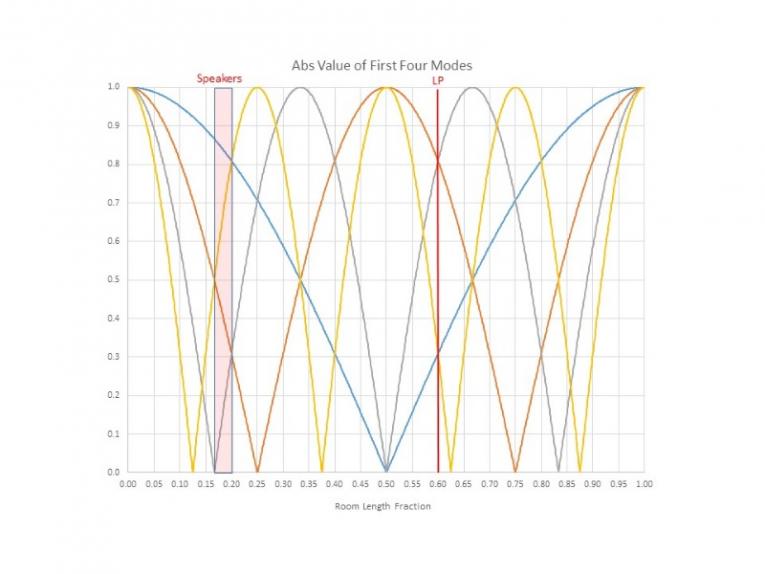- home Forum
- arrow_forward
- Support
- arrow_forward
- Triton Series
- arrow_forward
- Triton Towers
- arrow_forward
- Triton One Bass Response
 Triton One Bass Response
Triton One Bass Response
-
 Offline
Offline
- Platinum Member
-

- Posts: 599
- Thank you received: 904
- arrow_drop_downMore arrow_drop_upLess
This sounds very much like a low frequency room mode (standing wave) problem. Your listening position may be located at a nodal point (standing wave minimum), and if that node is deep enough, additional bass boost will probably not help. 100 times zero is still zero, which is why using room correction (EQ) might not help much either. Even adding another sub might not help.
I have also heard the phenomenon you describe, where there is very powerful bass nearer to a speaker. For me it was the area between my TV and the front wall, which at that time measured only a foot or so. There was a definite antinode (standing wave maximum) there that was quite intense. Now that the TV is farther out, the acoustic cavity there has changed, and I don't hear that severe reinforcement any more.
Yes, your cabinet may be involved in the problem if it's big enough to affect the distribution and shape of the low frequency room modes.
Is your listening position located near the middle of the room in the front/back direction? The middle is the worst spot for this and is very likely to result in wide swings in bass amplitude at the different room modes. Some will be very high in amplitude, and some will be near zero. (Left/right can suffer the same problem.) You can find room mode calculators on the web; just enter your room dimensions, and it will calculate the mode frequencies. Note that, if your room is close to square, that will cause F/B and L/R modes to be at the same frequency, and if you are seated in the middle of the room, you will have a worst case. If you are listening near the middle, is there any way you can move your listening position backward or forward? At least as a temporary experiment. That may allow you to escape the worst of the nodal point there.
As Art pointed out, some test tones can help you evaluate possible changes. Be sure to run them at low levels to avoid hurting the drivers. Like I did once.
Charlie
Please Log in or Create an account to join the conversation.
-
 Offline
school
Offline
school
- New Member
-

- Posts: 8
- Thank you received: 6
- arrow_drop_downMore arrow_drop_upLess
You've pretty much nailed it in terms of what I am experiencing.
My listening position is indeed at the center, which oddly is in accordance with all kinds of suggested setup tips, including Sandy's. The setup forms an equilateral triangle and the bass is indeed at its weakest right at the listening position. I'm roughly 60-70% to the back of the room and in the middle (between side walls) at this point, without much flexibility for dramatic movement.
I do recall reading about listening at roughly 33% depth as potentially optimized for this type of setup. that sound familiar?
I'm going to look into the test tones that Art recommended. Any suggestions for a node calculator would be appreciated.
It does sort of go against my better judgement to think that I'd need any subs to support the sound, but at this stage I'm at a loss. Will follow through on the advice here and report back. Thanks again!
Danalex
Please Log in or Create an account to join the conversation.
-
 Offline
school
Offline
school
- New Member
-

- Posts: 8
- Thank you received: 6
- arrow_drop_downMore arrow_drop_upLess
To answer your last question, I'll listen to a fairly wide variety of music and find the phenomenon to be more or less consistent.
Before I commit to any further purchase I'm going to look into the test tones as you've suggested and attempt to diagnose the room acoustics. Maybe it's time for a whole room upgrade
Danalex
Please Log in or Create an account to join the conversation.
-
 Offline
Offline
- Platinum Member
-

- Posts: 917
- Thank you received: 1811
- Karma: 1
- arrow_drop_downMore arrow_drop_upLess
In another thread in the forum ("Some News From Johnson City") I have been describing my experiences listening to music in a very different room in the house in Raleigh NC to which we are moving, as compared to my room in our old house in Johnson City TN.
I have been very surprised at the significant differences in sound between the two rooms. Part of this difference is the configuration of my speakers and the location of my PLP. In the old room my PLP was near the center of the room, whereas in the new room my PLP is along one of the side walls. Another factor is the different shapes of the two rooms and the sloping ceiling in the new room.
Therefore, I have read with much interest, Charlie's comments to you regarding room nodes, PLP location, etc. Low Bass wave lengths are measured in feet. These long wave lengths can be problematic, either causing cancellations or extra emphasis.
I think you are wise to consider experimenting with speaker placement , PLP location, and position of other items in your room before investing in additional subs. Another tool which you may find useful is a Sound Pressure Meter. This device measures the sound level in dbs. With it, you can see visually the difference in the strength of the sound wave at various room locations. A SLP Meter is not too expensive and they are readily available.
We will be interested in what you find.
Happy wave chasing.
Art
Please Log in or Create an account to join the conversation.
-
 Offline
Offline
- Moderator
-

- Posts: 3350
- Thank you received: 3419
- Karma: 19
- arrow_drop_downMore arrow_drop_upLess
Please Log in or Create an account to join the conversation.
-
 Offline
Offline
- Platinum Member
-

- Posts: 599
- Thank you received: 904
- arrow_drop_downMore arrow_drop_upLess
Danalex wrote: My listening position is indeed at the center, which oddly is in accordance with all kinds of suggested setup tips, including Sandy's. The setup forms an equilateral triangle and the bass is indeed at its weakest right at the listening position. I'm roughly 60-70% to the back of the room and in the middle (between side walls) at this point, without much flexibility for dramatic movement.
I do recall reading about listening at roughly 33% depth as potentially optimized for this type of setup. that sound familiar?
I'm going to look into the test tones that Art recommended. Any suggestions for a node calculator would be appreciated.
Danalex
Danalex,
I'm not suggesting that Sandy recommended sitting in the middle of the room, but he does recommend a equilateral setup, which I use. As Moderator Dude points out, these standing waves are caused by reflections from walls. At particular frequencies, these reflections can arrive just in time to reinforce or cancel, and this happens at particular locations in the room. The primary (axial) reflections bounce back and forth perpendicular to surfaces, but there are others (tangential and oblique waves) that are caused by grazing reflections off walls. The whole picture is very complicated, especially when you have slanted surfaces (my ceiling) or openings out of the room.
That said, you can at least start with looking at the primary waves that bounce back and forth along the main dimensions of the room, then modify your thinking as to possible effects from openings.
I'm attaching -- hopefully -- a diagram that I made that may help visualize what is going on. This is a plot of the amplitudes (absolute value) of the first four primary modes between two walls. The horizontal axis is the fraction of room length dimension, so you can use this to visualize front/back or left/right, or even up/down modes. Simply multiply the room length fraction by your room length (or width) and you get the location in the room. The curves show the locations of nodes (zero amplitude) and anti-nodes (maximum amplitude). Note that these have all been adjusted to have the same scale. Real modes may have different relative amplitudes. I have indicated on the plot where I have chosen to set up my speakers and listening position (LP) on the front/back dimension. The speakers are shown with a band because there are front and side bass drivers/radiators on the speakers. My selected positions worked out very well in terms of minimizing the effect of my front/back modes. At least this can give you a starting point to experiment with. Note that, as Moderator Dude pointed out, all modes are maximum at the walls, and you should hear very strong bass there. I located my speakers away from the front wall to help reduce the coupling between the speakers and the modes*.
The diagram is complicate looking, but will reward a little study. Any more modes and it would be unreadable.
You said you're at 60% to 70% to the back of the room. On the chart, my LP is located at 60%. How about that? But if you're about 63%, you'll be at a nodal point for one of the modes. I can actually hear this difference in my room.
As for mode calculators, there are many on the web. Here are a couple I found:
amcoustics.com/tools/amroc?l=19&w=14.5&h=10&ft=true&r60=0.6
www.mcsquared.com/modecalc.htm
These calculators will tell you the frequencies of the modes. The diagram I made shows how those modes change amplitude with position in the room.
*This may be radical thinking for some, and it is based on my experience in rotordynamics and balancing of rotating machinery. Believe it or not, the math is similar. The idea is that it's harder for a speaker to excite a room mode in the first place if it is located at a nodal point, while it is very easy to do so when the speaker is located at an anti-node. Locations in between provide medium excitation. All I can say is that it seems to have worked well for me.
Hope this helps. Moderator Dude, please don't shoot me.
Charlie
Please Log in or Create an account to join the conversation.
- home Forum
- arrow_forward
- Support
- arrow_forward
- Triton Series
- arrow_forward
- Triton Towers
- arrow_forward
- Triton One Bass Response
-
-

- Question Regarding SuperCinema 3D Array XL Center ...
- In Support / SuperCinema 3D Array
- by Moderator
- 4 days 3 hours ago
-
-
-

- Rumbling left speaker.
- In Write Your Own Review / Triton Series
- by Moderator
- 4 days 6 hours ago
-
-
-

- Triton Reference
- In Write Your Own Review / Triton Series
- by Moderator
- 5 days 7 hours ago
-
-
-

- Pair Triton One.Rs for sale $4500 Pennsylvania
- In Marketplace / For Sale/Trade
- by spdemon91
- 1 week 12 hours ago
-
-
-

- Help with repairs - Perth Australia
- In Advanced Topics / Problems and Solutions
- by Helvis
- 1 week 19 hours ago
-

